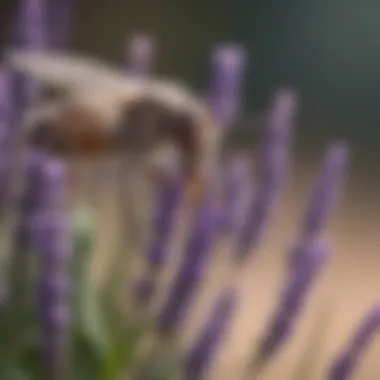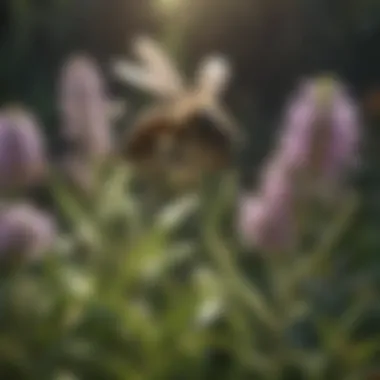Perennials That Deter Mosquitoes: Natural Solutions


Intro
The increasing nuisance of mosquitoes has prompted many to seek out natural solutions. Among these solutions, perennials stand out as effective deterrents. This guide highlights specific perennial plants that not only fend off these pests but also enrich the garden ecosystem. By incorporating these plants, gardeners can create a more enjoyable outdoor space while mitigating mosquito populations. This exploration will detail the functionality, maintenance requirements, and environmental benefits of these plants, providing valuable information to those looking to enhance their gardens.
Overview of Key Perennials That Deter Mosquitoes
Common Name and Scientific Classification
Some of the most effective perennials known to repel mosquitoes include:
- Lavender (Lavandula angustifolia)
- Catmint (Nepeta cataria)
- Marigold (Tagetes spp.)
These plants are recognized for their distinctive scents, which mosquitoes find unappealing. Understanding their classifications helps in identifying them in gardening resources.
Physical Characteristics
Each perennial varies in size, color, and aroma:
- Lavender: Tall, slender stalks adorned with purple flowers and a strong, calming fragrance.
- Catmint: Sprawling foliage with pretty lavender-blue flowers, aromatic leaves.
- Marigold: Bright yellow or orange flowers that provide a pop of color, known for their distinct spicy-scent.
Habitat and Distribution
These plants thrive in well-drained soil and prefer sunlit areas. Their adaptability allows them to flourish in various regions, making them suitable for diverse climates. For example, lavender thrives in Mediterranean conditions, while marigolds are commonly found in warmer climates across North America.
Benefits of Perennials for Mosquito Deterrence
Incorporating these plants into garden designs offers several benefits:
- Natural Repellent: Their natural scents deter mosquitoes effectively.
- Aesthetic Appeal: They add beauty to any garden with vibrant colors and textures.
- Environmental Impact: Promoting biodiversity by attracting beneficial insects like bees and butterflies.
Gardening with these plants enhances outdoor spaces while minimizing the use of chemical repellents.
Maintenance Needs
Maintaining these perennials is vital for maximizing their repellant properties:
- Lavender: Requires full sun and well-drained soil. Trim annually to promote growth.
- Catmint: Low maintenance, tolerates drought, and should be cut back after flowering for reblooming.
- Marigold: Water regularly but ensure soil drains well. Deadhead spent flowers to encourage new growth.
Regular care ensures these plants remain healthy and effective.
Ending
The use of perennials to deter mosquitoes is both a practical and ecologically sound solution. Through careful selection and maintenance of these plants, it is possible to create a more enjoyable and pest-free outdoor environment. By integrating species like lavender, catmint, and marigolds into garden designs, individuals can effectively reduce mosquito populations while enhancing their outdoor spaces.
Foreword to Mosquito Control
Mosquito control is an essential topic in both urban and rural settings. These pests not only cause discomfort but also pose significant health risks. Diseases such as West Nile virus, Zika virus, and malaria are transmitted by mosquitoes, making them a substantial threat to public health. Therefore, effective mosquito management strategies are vital to ensure safe outdoor environments.
Understanding how to control mosquito populations effectively is increasingly important for families who wish to enjoy their gardens and outdoor spaces. Traditional methods often involve the use of chemical repellents and pesticides. However, these can have harmful effects on the ecosystem. This is where natural solutions, like planting certain perennials, come into play.
Incorporating mosquito-repelling plants not only offers a sustainable alternative but also enhances the aesthetic appeal of gardens and landscapes. Additionally, these perennials can serve multiple purposes in landscaping. They provide beauty, support local wildlife, and contribute to biodiversity. The following sections will delve into the specifics of the mosquito problem and the role perennials play in mitigating this pervasive issue.
Understanding the Mosquito Problem


Mosquitoes are a nuisance known for their buzzing and biting, but the problem extends beyond mere annoyance. The female mosquito requires blood for her eggs, which often leads to painful bites. According to the World Health Organization, mosquitoes are responsible for millions of infections each year, underscoring the significance of understanding their breeding habits and behaviors.
Mosquito populations thrive in warm, humid environments, making specific regions more susceptible to infestations. Areas with standing water, such as ponds and puddles, serve as breeding grounds. Even small amounts of water can become a mosquito habitat. It is crucial to identify and eliminate these sources to control their numbers effectively.
In urban settings, improper waste management can further exacerbate the problem. Disposing of containers that accumulate rainwater is a step in the right direction. Also, awareness is necessary for communities to work together in controlling these pests. Additionally, knowledge about when mosquitoes are most active can aid in making informed decisions about outdoor activities.
The Role of Perennials in Landscaping
Perennials offer a practical solution to the mosquito problem by serving as natural deterrents. These plants have evolved various ways to repel mosquitoes, primarily through their scents and oils. Essential oils extracted from certain perennials can deter these pests effectively and are often used in homemade repellents.
Integrating mosquito-repelling perennials not only contributes to pest control but also adds diversity to garden landscapes. These plants can attract beneficial insects, such as pollinators, which are vital for the ecosystem. By designing a garden with these considerations, families can enjoy their outdoor space more fully without facing the constant nuisance of mosquitoes.
Moreover, incorporating perennials into landscaping reduces the need for chemical pesticides. This sustainable approach protects both human health and the environment. Understanding the specific types of perennials that effectively deter mosquitoes is essential for anyone considering this natural avenue for pest control.
Overview of Perennials That Deter Mosquitoes
In the quest for sustainable mosquito control, perennials that deter these pests stand out. These plants not only beautify gardens but also serve important functions in the ecosystem. When executed carefully, incorporating mosquito-repelling perennials into landscaping can lead to significant ecological benefits. It provides a dual purpose: decoration and pest control.
Definition of Perennials
Perennials are plants that live for more than two years. Unlike annuals, which die off after one season, perennials return, year after year. Many of them have deep root systems, which help to stabilize the soil and contribute to its health. This characteristic not only enhances the environment but also makes them easy to manage in a garden setup. They often require less maintenance than annuals, since established plants do not need to be replanted each year.
Some common examples of perennials include lavender, marigold, and peppermint. Each has unique features and maintenance needs, and some exhibit properties that repel mosquitoes effectively.
How Certain Perennials Repel Mosquitoes
The effectiveness of perennials in repelling mosquitoes stems from their natural chemical compounds. For instance, lavender emits a scent that is undesirable to mosquitoes, making it a popular choice in gardens meant to deter these pests. Similarly, marigolds contain pyrethrum, a natural insect repellent widely used in various pest control products.
Catnip, another potent perennial, contains nepetalactone, which is highly effective at driving mosquitoes away. Studies suggest that catnip can be up to ten times more effective as a repellent than DEET, a common chemical found in commercial repellents.
The combination of these plants not only disrupts the scent trails mosquitoes rely on but also creates an environment less favorable for their breeding. Creating a diverse garden with these perennials can reduce the local mosquito population without resorting to chemical solutions.
Incorporating perennials that deter mosquitoes not only enhances outdoor aesthetics but effectively supports a healthier and more enjoyable living space.
Ultimately, understanding the role of these plants provides valuable insights into natural pest control. By selecting the right perennials and understanding their properties, one can effectively protect themselves and their families from mosquito-related nuisances.
Specific Perennials Known for Mosquito Repellent Properties
The topic of specific perennials that deter mosquitoes is crucial for anyone interested in creating a pleasant outdoor environment. Using these plants can significantly reduce mosquito populations while promoting a healthy ecosystem. Their natural repellant properties provide an organic alternative to chemical sprays and solutions. Understanding how these plants function and their benefits is essential for effective pest management.
Lavender
Lavender is well-known for its calming fragrance and vibrant purple blooms. This perennial not only serves as a beautiful addition to any garden, but it also has potent mosquito-repelling qualities. The strong scent of lavender is pleasant to humans but can be overwhelming to mosquitoes, making it an effective natural deterrent.
Growing lavender requires well-drained soil and a sunny location. It prefers a pH level between 6.5 and 7.5. Once established, lavender is drought-resistant and requires minimal maintenance, only needing pruning once a year for optimal growth. Additionally, it attracts pollinators like bees and butterflies, contributing to biodiversity in your garden.
Lavender's essential oil can also be extracted and used as a natural insect repellent.
Marigold
Marigolds are another attractive option for those looking to deter mosquitoes. The vibrant colors of marigolds can brighten up any garden space, but they have more to offer than aesthetics. Marigolds contain compounds like pyrethrum, which are known for their insecticidal properties. This makes them effective at repelling not just mosquitoes but a range of other garden pests as well.
Planting marigolds requires full sun and well-drained soil. They thrive in a variety of conditions but do best in a slightly acidic to neutral pH. Regular deadheading encourages new blooms and keeps the plants vigorous throughout the growing season. These perennials are also beneficial for companion planting, which can enhance the growth of other plants nearby.
Catnip


Catnip (Nepeta cataria) is often famous for its effects on felines, but it also has remarkable mosquito-repelling abilities. Studies indicate that essential oils derived from catnip can be more effective than DEET, a common chemical repellent. Its aroma is pleasant for humans but drives mosquitoes away.
Ideal growing conditions for catnip include full sun and well-drained soil. It can tolerate a variety of soil types, making it easy to maintain. Catnip can spread easily, thus regular monitoring is advised to prevent it from overwhelming other garden plants. The leaves can be dried and used in herbal tea or even as cat toys, making it quite a versatile plant.
Peppermint
Peppermint is a popular herb known for its strong flavor and aroma. Its unmistakable scent is also highly effective in deterring mosquitoes. The oil extracted from peppermint leaves contains menthol, which is unpleasant for mosquitoes, providing an additional reason to plant it in your garden.
Peppermint grows best in partial shade but can also thrive in full sun. It prefers moist, rich soil and requires regular watering. Since it can spread quickly, planting it in containers is often a wise decision. Using peppermint leaves in cooking offers dual benefit—creating a pest-free environment while also enhancing your meals.
Basil
Basil is well-loved for its culinary uses, particularly in dishes like pesto. However, it's lesser-known capacity as a mosquito repellent is noteworthy. The strong scent of basil leaves confuses and repels mosquitoes, making it a practical addition to both gardens and kitchens.
Basil enjoys warm weather and needs full sun with well-drained soil. Regular pinching back of the leaves encourages bushy growth and can also keep the plant producing throughout the summer. In addition to repelling mosquitoes, basil can enhance the taste of various dishes and is simple to incorporate into daily cooking.
Planting and Maintenance Considerations
Understanding how to plant and maintain perennials is critical to maximizing their effectiveness as mosquito deterrents. The right conditions and care ensure that these plants thrive and perform optimally, offering their natural repellent properties. By considering various factors, one can create a productive garden that also minimizes the presence of mosquitoes.
Optimal Growing Conditions
Each perennial species has its own specific growing requirements. It is essential to understand these conditions to ensure healthy plants. Here are some factors to consider:
- Sunlight: Many mosquito-repelling perennials like lavender and marigold need full sunlight. Aim for at least six hours of direct sunlight daily.
- Soil Type: Well-draining soil is vital for most perennials. Sandy or loamy soils tend to work best, allowing roots to breathe while preventing water stress.
- Temperature: While some plants can endure a variety of climates, optimum temperatures typically range between 60°F and 75°F. Be mindful of hardiness zones to select plants suited to your region.
Ensuring these optimal conditions helps to maximize growth rates and enhance the effectiveness of the plants in repelling mosquitoes.
Watering and Fertilization Requirements
Watering and fertilization play crucial roles in the survival and health of these perennials. Here is a closer look at both:
- Watering: Most perennials require deep watering rather than frequent light watering. Establish a routine, ensuring the soil remains consistently moist but not soggy. It is advisable to water during the early morning or late evening to reduce evaporation.
- Fertilization: Providing a balanced, organic fertilizer during the growing season can support healthy growth. Use slow-release fertilizers, typically high in phosphorus. This component boosts root development, which helps plants withstand stress and thrive.
Adjust watering and fertilization based on specific plant needs, as over-fertilizing can lead to excessive foliage, which may actually attract more mosquitoes.
Pruning and Care Techniques
Regular maintenance of your perennials is vital for preventing overcrowding and ensuring proper air circulation. Here are some key techniques:
- Pruning: Trim dead or yellowing leaves regularly. This practice prevents disease and maintains the aesthetic appeal of your garden. It also encourages new growth which can be more effective at repelling mosquitoes.
- Dividing: Every few years, perennials may need dividing to avoid overcrowding. This practice enhances air circulation and ensures that each plant has enough resources.
- Pest Management: Monitor for pests carefully. Organic pest control methods should be prioritized to protect the health of the plants and surrounding ecosystem.
Proper care techniques not only promote plant health but also enhance the garden's ecological balance, further minimizing mosquito attraction.
Understanding planting and maintenance is not just about aesthetics. It is a strategic approach to cultivating a mosquito-repelling environment.
Incorporating these considerations into your gardening routine will lay a solid foundation for a thriving landscape that effectively deters mosquitoes while being aesthetically pleasing.
Environmental Impact of Using Perennials
Incorporating perennials into landscapes not only serves functional purposes in mosquito control but also delivers substantial environmental benefits. These plants contribute to ecological balance and can play a crucial role in biodiversity support. By understanding these factors, we can appreciate the broader implications of using perennials beyond their immediate aesthetic and health benefits.
Biodiversity Benefits
Perennials that deter mosquitoes often support a wide variety of wildlife. These plants can provide habitat and food sources for beneficial insects, birds, and other animals. For example:


- Nectar Production: Many mosquito-repelling plants, such as catnip and lavender, produce nectar that attracts pollinators like bees and butterflies.
- Natural Pest Control: By encouraging populations of beneficial insects, these perennials help manage pest species naturally, reducing the need for chemical pesticides.
- Supporting Soil Health: Deep-rooted perennials improve soil structure and fertility, promoting healthier ecosystems.
The promotion of biodiversity in gardens enriched with these plants can create a self-sustaining environment that reduces reliance on artificial measures for pest management.
Impact on Local Ecosystems
The effects of introducing mosquito-repelling perennials extend to local ecosystems, creating a tapestry of interactions vital for maintaining a balanced environment. Consider the following aspects:
- Improved Air Quality: Planting diverse vegetation helps in carbon sequestration and enhances air quality, benefiting all organisms in the vicinity.
- Water Management: Perennials often require less water than traditional lawns, reducing water runoff and promoting groundwater recharge.
- Soil Erosion Prevention: The root systems of perennials hold soil together, decreasing erosion and preserving the landscape.
- Resilience to Climate Change: Diverse plant life contributes to ecosystem resilience, allowing communities to better adapt to changing climate conditions.
“Using perennials effectively can help restore ecological balance in urban and rural spaces, proving that a well-planned garden can nurture both people and wildlife.”
In summary, integrating perennials that deter mosquitoes into landscapes contributes to enhancing biodiversity and strengthening local ecosystems. Their positive impacts showcase the alignment between pest management and sustainable environmental practices.
Complementary Strategies for Mosquito Control
The effectiveness of using perennials to deter mosquitoes can be significantly enhanced through complementary strategies. These methods not only support the functionality of the plants but also create a more comprehensive approach to mosquito management. Understanding additional techniques can lead to a more successful outcome in keeping mosquito populations at a manageable level.
Incorporating Companion Planting
Companion planting involves growing different plants in proximity for mutual benefits. This strategy can be very useful for mosquito control. Some plants naturally repel mosquitoes due to their odor or specific compounds. For instance, citronella and basil not only enhance the garden's appearance but also provide natural deterrence against mosquitoes.
When planning a garden, consider mixing repelling perennials like lavender and marigold with vegetables or herbs. This natural synergy can confuse or deter mosquitoes from invading the space. Additionally, plants such as garlic have strong scents that can repel not just mosquitoes but various pests as well.
Research has shown that certain aromatic plants release oils that can mask the scent of humans and other attractants, further minimizing mosquito activity in gardens.
Incorporating these strategies into your garden creates a multi-layered defense system. Monitor the growth of the companion plants, as their health plays a role in the overall effectiveness of the strategy.
Maintaining a Clean Environment
A clean environment is essential in reducing mosquito populations. Even with effective planting strategies, the presence of standing water or debris can create breeding grounds for mosquitoes. Maintaining cleanliness in and around the garden is crucial.
Here are some important considerations:
- Regular Cleaning: Ensure that gutters are clear of debris and that bird baths or other water features are cleaned or emptied regularly.
- Eliminate Standing Water: Check for areas where water might collect and eliminate these spots. This includes flower pot saucers and old tires.
- Proper Waste Management: Dispose of organic waste properly. Composting should be done in enclosed bins that do not attract mosquitoes.
- Trim Vegetation: Keep the area around perennials well-trimmed. Overgrown plants can provide a resting place for adult mosquitoes.
By combining companion planting with a commitment to cleanliness, gardens can become significantly less inviting to mosquitoes. Such a dual approach ensures that environmental conditions do not counteract the benefits offered by various perennials. This strategy fosters healthier outdoor spaces while effectively managing mosquito populations.
The End: The Future of Mosquito Control through Perennials
The integration of perennials into mosquito control strategies presents a significant step forward in creating healthier outdoor environments. As urban areas grow, so does the need for effective methods to manage mosquito populations. Utilizing perennials not only targets mosquitoes specifically, but also enhances the overall landscape. This approach promotes biodiversity, conserves resources, and aligns with sustainable practices in gardening and landscaping.
Moreover, the benefits extend beyond mere mosquito deterrence. The right selection of perennials contributes to soil health and provides habitats for beneficial insects, fostering an ecosystem that can thrive. By cultivating a garden imbued with diverse plant life, homeowners and city planners can create spaces that are aesthetically pleasing and rich in ecological value.
Sustainable Practices in Landscaping
When discussing the future of mosquito control through perennials, sustainable landscaping practices become integral. These practices prioritize environmental health and resource conservation. Here are key aspects to consider:
- Native Plant Selection: Using local perennials helps to ensure that the plants are well-adapted to the local climate and soil, reducing the need for chemical fertilizers and pesticides.
- Water Efficiency: Implementing drip irrigation systems supports water conservation. This both reduces standing water—breeding ground for mosquitoes—and provides direct watering to the roots of perennials.
- Organic Soil Practices: Utilizing compost or organic fertilizers can enhance soil quality, encouraging robust plant growth which plays a vital role in natural pest deterrence.
“Sustainable landscaping creates a balance that accommodates both human enjoyment and ecological integrity.”
Encouragement for Further Research
Encouraging ongoing research into perennials and their role in mosquito control can lead to further innovations in this field. There remains a wealth of untapped knowledge regarding various plant species and their respective effects on pests. Academic institutions and independent researchers can explore:
- The efficacy of under-studied perennial species in repelling specific mosquito breeds.
- The long-term ecological impacts of incorporating such plants into existing landscapes.
- The exploration of companion planting strategies that maximize pest deterrence using perennials.
This commitment to research supports not only the practicality of pest control but also the necessary evolution of green spaces. By adopting a proactive stance toward understanding these plants, communities can enhance their resilience against mosquito populations while fostering biodiversity.
By connecting effective mosquito control with the sustainable use of perennials, we pave the way for healthier living spaces and contribute positively to the environment. This dual focus enriches our landscapes and promotes harmonious interactions among all living things.







